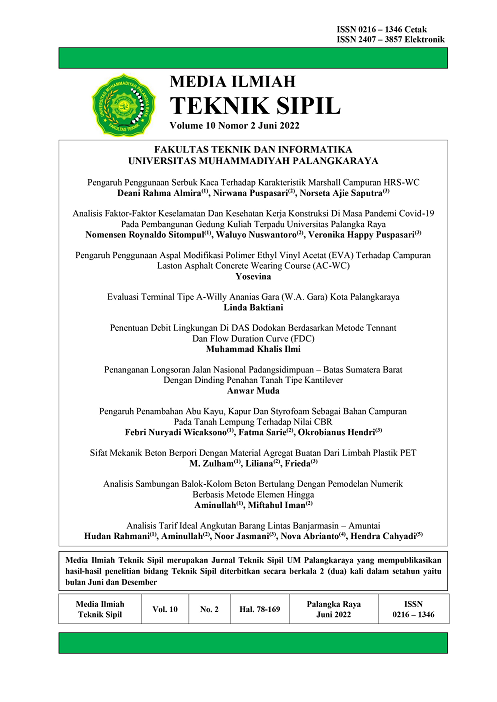Penentuan Debit Lingkungan Di DAS Dodokan Berdasarkan Metode Tennant Dan Flow Duration Curve (FDC) Determination Of Environmental Flow In Dodokan Watershed Based On Tennant And Flow Duration Curve (FDC) Method
Main Article Content
Abstract
The Dodokan Watershed (DAS) is a watershed that is included in one of the national priority watersheds, so it is necessary to monitor and evaluate the watershed management on a regular basis. One very important aspect in monitoring and evaluating watershed management is the determination of the amount of environmental discharge. Environmental discharge in Indonesia is known as river maintenance flow which is intended in the context of river management to maintain river ecosystems. The amount of river maintenance flow in Indonesia is regulated in PP No. 38 of 2011 concerning rivers, namely Q95% mainstay discharge. The purpose of this study was to determine the amount of environmental discharge in the Dodokan watershed as one of the river management efforts in the future. The method used is the hydrological method, namely the Tennant method and flow duration curve (FDC). The Tennant method recommends that the minimum flow is set relative to the annual average flow and in the FDC method the daily discharge data is processed into a certain percentage as the probability value of the event using Weibull theory. The results showed that the environmental discharge interval using the Tennant and FDC methods was 0.01–0.2 m3/s, from this interval it can be seen that the flow characteristics in the Dodokan watershed have a very small minimum quantity. This situation illustrates that the carrying capacity of the Dodokan watershed is in a declining condition so it is necessary to carry out proper watershed management in accordance with existing conditions
Downloads
Article Details
All rights reserved. This publication may be reproduced, stored in a retrieval system, or transmitted in any form or by any means, electronic, mechanical, photocopying, recording.
References
Balai Wilayah Sungai Nusa Tenggara I. 2012. Data dan Informasi Pengelolaan Sumber Daya Air Wilayah Sungai Lombok dan Wilayah Sungai Sumbawa. Mataram: Kementerian Pekerjaan Umum Direktorat Jenderal Sumber Daya Air Balai Wilayah Sungai Nusa Tenggara I.
Balai Wilayah Sungai Nusa Tenggara I. 2014. Katalog DAS Dodokan. Lombok: BWS Nusa Tenggara I.
Bengen, et al. 2012. Menguak Realitas dan Urgensi Pengelolaan Berbasis Eko-sosial Sistem Pulau-pulau Kecil. Cetakan Ketiga. Bogor: Pusat Pembelajaran dan Pengembangan Pesisir dan Laut (P4L).
Gopal, B.R. 2013. Methodologies for the assessment of environmental flows. Environmental flows: An introduction for water resources managers, pp.129-182.
Hakim, R. 2017. mengkhawatirkan 70% DAS di NTB Kritis. [online] tersedia di: https://www.suarantb.com/headline/2017/03/27747/mengkhawatirkan.70.persen.das.di.ntb.kritis/ [diakses tanggal 23 Agustus 2018]
Harto, S. 1993. Analisis Hidrologi. Jakarta: PT Gramedia Pustaka Utama
Jowett, I.G. 1997. Instream Flow Methods: A Comparison of Approaches. Regulated Rivers: Research & Management, Vol. 13, 115–127 (1997). Niwa,Box 11-115, Hamilton, New Zealand. John Wiley & Sons, Ltd p. 115-127
Linsley, R. K dan Franzini, J. B. 1995. Water Resources Engineering. Singapore: McGraw-Hill International Editions.
Olden, J.D dan Poff, N.L. 2003. Redudancy and the choice of hydrologic indicies for characterizing streamflow regimes. Rivers Research and Applications 19: 101-121.
Patty, O. F., 1995. Tenaga Air. Fakultas Teknik Jurusan Teknik Sipil Universitas Kristen Petra Surabaya.
Pemerintah Republik Indonesia. 2011. Peraturan Pemerintah No.38 tahun 2011 tentang Sungai. Jakarta: Sekretariat Negara
Redjekiningrum, P. 2011. Development of Water Allocation Model for Supporting Optimal Water Sharing: A Case of Cicatih-Cimandiri Watershed, District of Sukabumi, West Java. Indonesia: Sekolah Pascasarjana Institut Pertanian Bogor (Doctoral dissertation, Dissertation)
Soewarno. 1991. Hidrologi, Pengukuran dan Pengolahan Data Aliran Sungai Hidrometri. Bandung: Nova.
Tennant, D.L. 1976. Instream flow regimes for fish, wildlife, recreation and related environmental resources. Pages 359-373, In: Orsborn, J. F.and Allman, C.H. (Editors). Proceeding of the symposium and specialty conference on Instream Flow Needs. American Fisheries Society, Bethesda.
Tharme, R.E. 2003. A global Perspective on Environmental Flow Assesment: Emerging Trends in the Development and Application of Environmental Flow Trends in the Development and Application of Environmental Flow Methodologies for Rivers. River Research and Applications 19, 397-441.
Triatmodjo. 2008. Hidrologi Terapan. Yogyakarta: Beta Offset
